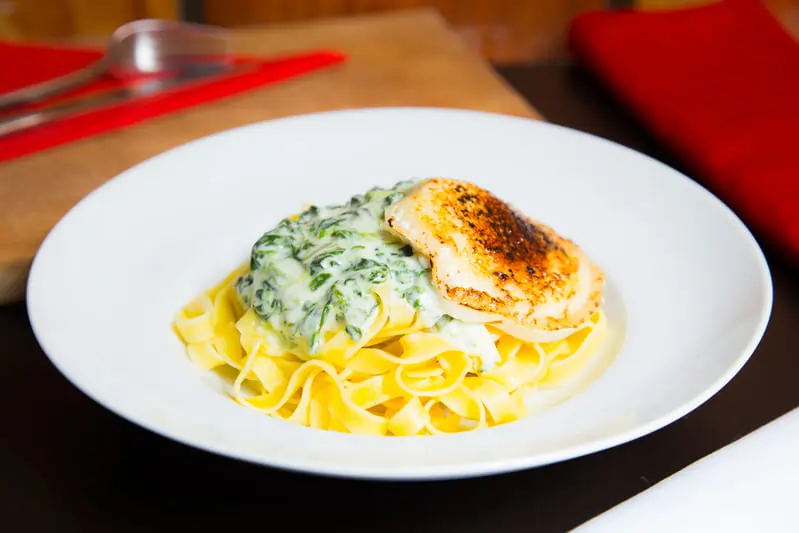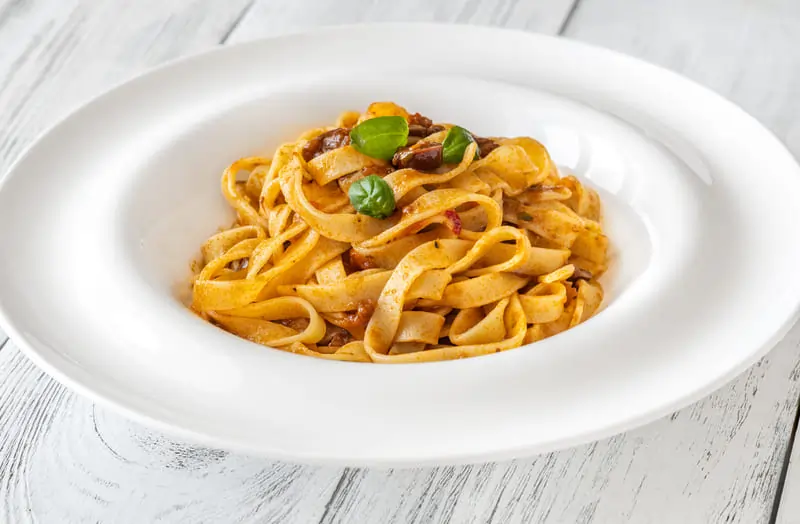Fettuccine carbonara is a simple yet exquisite Italian pasta dish that has captured the hearts of food lovers globally. With its creamy texture, savory flavor, and rich ingredients, this dish represents the best of Roman cuisine. Let’s dive into the essential components that make fettuccine carbonara a timeless classic.
For more classic pasta recipes, explore How to Make Fettuccine Carbonara.
Core Ingredients of Fettuccine Carbonara
The essence of fettuccine carbonara lies in its carefully selected, high-quality ingredients. Each component contributes to the dish’s signature balance of creaminess, saltiness, and umami flavors. Below is a detailed look at the core ingredients that make this dish an iconic representation of Italian cuisine.1. Fettuccine
The choice of pasta plays a crucial role in carbonara’s overall texture and flavor delivery:
- Fettuccine’s Wide Ribbons: The flat, ribbon-shaped structure of fettuccine holds the creamy carbonara sauce exceptionally well, ensuring every bite is rich and satisfying.
- Alternative Pasta Options: While spaghetti and bucatini are commonly used in carbonara, fettuccine offers a unique texture that adds a velvety mouthfeel to the dish.
- Why It Works: Its surface area provides maximum contact with the sauce, making it an ideal choice for this indulgent recipe.
For more inspiration on how simplicity can transform a dish, explore The Ultimate Guide to Making 5-Ingredient Banana Bread, where minimal ingredients shine in creative ways.
2. Eggs
Eggs are the foundation of carbonara’s luxurious sauce, providing its silky texture and rich flavor:
- Fresh, Room-Temperature Eggs: Using room-temperature eggs helps them blend more smoothly with Pecorino Romano, reducing the risk of clumping. The yolks, in particular, contribute to the sauce’s luscious creaminess.
- The Role of Tempering: Whisking eggs with a splash of hot pasta water before combining with the pasta ensures they cook gently, creating a glossy, custard-like sauce rather than scrambling.
3. Pecorino Romano Cheese
This tangy and salty cheese is an essential ingredient in authentic carbonara, bringing bold flavor to the dish:
- Distinctive Flavor: Made from sheep’s milk, Pecorino Romano delivers a sharp and slightly nutty taste that cuts through the richness of the sauce.
- Substitution Options: While Parmesan can be used as a milder alternative, it lacks the distinctive tanginess of Pecorino Romano, which is crucial for balancing the dish’s flavors.
- Texture Matters: Finely grating the cheese ensures it melts evenly into the sauce, avoiding lumps and creating a smooth, cohesive mixture.
For an in-depth look at cheese varieties and their uses, visit this Italian Cheese Varieties Guide, which highlights how different cheeses enhance traditional dishes.
4. Guanciale
Guanciale is the traditional choice for carbonara, lending the dish its smoky, umami-rich depth:
- Flavor Profile: Made from cured pork jowl, guanciale has a robust, fatty flavor that crisps beautifully when rendered, releasing savory oils that coat the pasta.
- Substitutes: If guanciale is unavailable, pancetta or thick-cut bacon can be used, though they lack guanciale’s authentic richness. Pancetta is less fatty, while bacon may introduce a smoky element that differs from the original Roman recipe.
- Cooking Tip: Render guanciale slowly over medium heat to maximize flavor without burning the meat or its fat.
5. Black Pepper
A generous sprinkle of freshly cracked black pepper is the perfect finishing touch for carbonara:
- Flavor Enhancement: The pepper’s subtle heat contrasts beautifully with the creamy sauce, adding depth and complexity to the dish.
- Use Freshly Ground Pepper: Pre-ground pepper lacks the same intensity and aroma. Grinding fresh pepper directly into the dish ensures a vibrant, aromatic punch.
How These Ingredients Work Together
The harmony of these ingredients is what makes fettuccine carbonara so beloved:
- The fettuccine provides the perfect canvas, its wide ribbons coated in the creamy egg-and-cheese sauce.
- Guanciale adds savory richness, with its rendered fat infusing every strand of pasta.
- The sharpness of Pecorino Romano balances the sauce’s creaminess, while black pepper introduces a layer of warmth and spice.
Optional Additions in Modern Carbonara Recipes

While traditional carbonara strictly adheres to its essential ingredients—eggs, Pecorino Romano, guanciale, and black pepper—modern variations have introduced optional additions to cater to diverse palates. These ingredients can enhance the dish’s richness, depth, and presentation, though they deviate from the authentic Roman recipe.
1. Cream
Adding cream to carbonara is a topic of heated debate among purists, but it has become a popular addition in some modern interpretations:
- Why It’s Used: A splash of cream lends extra richness and a velvety texture to the sauce. It can also help stabilize the egg mixture, making the dish more forgiving for beginner cooks.
- When to Use It: Cream is especially useful in recipes that aim for a heavier, more indulgent flavor profile. However, it’s important to use sparingly to avoid overpowering the delicate balance of traditional ingredients.
2. Garlic and Onion
Though not part of the original recipe, garlic and onion have found their way into contemporary carbonara variations:
- Garlic: Sautéing garlic in the rendered guanciale fat adds a warm, aromatic layer of flavor. It’s a subtle addition that blends well with the dish’s other components.
- Onion: Finely chopped onion brings sweetness and depth, creating a more complex flavor profile. However, its inclusion is considered non-traditional and changes the dish’s character.
3. Parsley
Fresh parsley is a popular garnish in modern carbonara recipes, offering a burst of color and a hint of herbal freshness:
- Why It’s Added: Parsley lightens the dish’s overall richness, making it feel more balanced and visually appealing.
- How to Use It: Chop the parsley finely and sprinkle it over the plated pasta just before serving for a vibrant finish.
How These Additions Impact the Dish
While these optional ingredients can add unique flavors and textures, they also stray from the simplicity and authenticity of traditional carbonara. The decision to include them often depends on personal preference and the intended audience for the dish.
For More Creative Recipe Inspiration
If you’re intrigued by the idea of blending tradition with innovation, explore this Matcha Tiramisu Recipe, which fuses Japanese and Italian culinary elements into a single, stunning dessert.
How Fettuccine Carbonara is Made
Creating the perfect fettuccine carbonara involves a balance of technique and high-quality ingredients. This classic Italian dish is known for its creamy, flavorful sauce without the use of heavy cream. Follow these detailed steps to prepare an authentic carbonara that’s both satisfying and elegant.
Step 1: Prepare the Ingredients

Proper preparation ensures smooth cooking and a cohesive dish:
- Dice the Guanciale: Cut 150g of guanciale into small cubes for even cooking. If guanciale is unavailable, pancetta or thick-cut bacon can be used, though they will slightly alter the flavor profile.
- Grate the Pecorino Romano: Finely grate 100g of Pecorino Romano cheese. Fine grating ensures the cheese melts smoothly into the sauce.
- Whisk the Sauce Mixture: In a bowl, whisk together 4 large eggs, the grated Pecorino Romano, and freshly cracked black pepper. The result should be a thick, cohesive mixture that serves as the base for the creamy sauce.
Step 2: Cook the Pasta
The pasta is the foundation of this dish, so cooking it to perfection is crucial:
- Bring a large pot of water to a boil and season generously with salt. This ensures the pasta is well-flavored.
- Add 400g of fettuccine and cook until al dente, following the package instructions. Al dente pasta provides the ideal texture for absorbing the sauce.
- Reserve Pasta Water: Before draining the pasta, save 1 cup of pasta water. The starchy water is essential for emulsifying the sauce and achieving the desired creaminess.
For more insights into perfecting cooking techniques, visit Why Is My Banana Bread Not Moist? Troubleshooting Common Baking Issues, which explores similar methods like managing moisture and texture.
Step 3: Render the Guanciale
The rendered fat from guanciale adds rich, smoky flavor to the pasta:
- Heat a large skillet over medium heat and add the diced guanciale.
- Cook slowly, allowing the fat to render out while the guanciale becomes golden and crispy. This process enhances the flavor and creates a rich base for the sauce.
- Once the guanciale is crispy, remove the skillet from the heat but leave the rendered fat in the pan. The fat will coat the pasta and help bind the sauce.
Step 4: Combine Pasta and Sauce
This step requires precision to achieve the signature creamy carbonara sauce:
- Add the cooked fettuccine to the skillet with the rendered guanciale fat. Toss well to coat the pasta evenly with the flavorful fat.
- Off the Heat: Remove the skillet from direct heat before adding the egg mixture. This step prevents the eggs from scrambling.
- Pour the whisked egg mixture over the pasta and immediately add a splash of the reserved pasta water. Stir quickly and continuously to create a smooth, glossy sauce. The residual heat from the pasta will gently cook the eggs, resulting in a creamy, custard-like texture.
- If needed, add more reserved pasta water, a little at a time, to adjust the sauce’s consistency.
Final Touches
- Plate the pasta and garnish with additional grated Pecorino Romano and freshly cracked black pepper for an extra layer of flavor.
- Serve immediately to enjoy the dish at its peak creaminess and flavor.
Tips for Success
- Avoid High Heat: Always mix the sauce off the heat to prevent scrambling the eggs.
- Work Quickly: The key to creamy carbonara is tossing the pasta and sauce together rapidly while the pasta is still hot.
- Season Thoughtfully: Guanciale and Pecorino Romano are naturally salty, so additional salt may not be necessary.
For more guidance on mastering classic techniques, check out Matcha Tiramisu: A Perfect Fusion of Japanese and Italian Flavors, where balance and preparation are key to success.
Variations of Fettuccine Carbonara
While traditional fettuccine carbonara celebrates simplicity with its classic combination of eggs, Pecorino Romano, guanciale, and black pepper, modern variations introduce creative twists to suit diverse preferences. Here are two popular adaptations that bring new flavors to this iconic dish:
1. Vegetarian Carbonara
For those seeking a meat-free version, vegetarian carbonara offers the same creamy and satisfying experience with plant-based ingredients:
- Smoked Mushrooms: Replace guanciale with smoked mushrooms such as portobello or shiitake. These mushrooms provide a rich, umami flavor and a slightly chewy texture that mimics the heartiness of guanciale. Sauté them in olive oil or butter until golden brown to enhance their smokiness.
- Plant-Based Bacon: Another excellent alternative is plant-based bacon, which adds a crisp texture and smoky notes to the dish. Cook the bacon substitute until crispy, then use its fat (or olive oil) to coat the pasta.
- Cheese Options: Stick to traditional Pecorino Romano for its sharp tang or try vegetarian Parmesan if preferred.
For more ideas on transforming traditional recipes into plant-based delights, explore this guide on How Matcha Impacts Baking, showcasing how simple swaps can redefine a classic dish.
2. Seafood Carbonara
Adding seafood to carbonara elevates the dish with luxurious flavors and textures:
- Prawns (Shrimp): Sauté prawns in olive oil or butter until pink and slightly caramelized. Their natural sweetness pairs beautifully with the creamy sauce and salty Pecorino Romano.
- Scallops: Pan-seared scallops bring a tender, buttery richness to the dish. Their delicate flavor complements the boldness of the carbonara sauce without overpowering it.
- Cooking Tip: Cook the seafood separately and add it to the pasta after combining the sauce. This ensures the seafood retains its perfect texture and doesn’t become overcooked.
For another luxurious take on Italian-inspired recipes, check out Matcha Tiramisu: A Perfect Fusion of Japanese and Italian Flavors, which combines elegance with unique ingredients.
Why These Variations Work
Both adaptations honor the creamy, savory essence of carbonara while introducing new elements that expand its appeal:
- Vegetarian Carbonara highlights smoky, umami-rich ingredients like mushrooms and plant-based alternatives for those avoiding meat.
- Seafood Carbonara adds an indulgent touch with prawns or scallops, perfect for special occasions or when you want to elevate your pasta game.
Tips for the Perfect Carbonara
Crafting the perfect carbonara requires precision and attention to detail. By focusing on ingredient quality and proper technique, you can achieve a dish that’s creamy, flavorful, and true to its Italian roots. Here are essential tips to ensure success:
1. Use Fresh, High-Quality Ingredients
The simplicity of carbonara means that the quality of each ingredient significantly impacts the final result:
- Eggs: Opt for fresh, room-temperature eggs. Their natural richness and vibrant yolks contribute to the creamy texture and golden color of the sauce.
- Pecorino Romano: This sharp, tangy cheese is integral to the dish’s flavor. Choose authentic Pecorino Romano and grate it yourself for maximum freshness and a smoother sauce.
- Guanciale: This cured pork jowl is a must for authentic carbonara, offering a rich, fatty flavor that crisps beautifully when rendered. Pancetta or thick-cut bacon can work as substitutes, but they lack guanciale’s traditional depth.
For guidance on incorporating fresh ingredients into recipes, explore The Ultimate Guide to Making 5-Ingredient Banana Bread, which emphasizes how simplicity can elevate a dish.
2. Avoid High Heat
Carbonara’s creamy sauce relies on eggs and cheese emulsifying with the rendered fat and pasta water—not cooking directly on heat:
- Mix Off the Heat: Always remove the skillet from direct heat before adding the egg and cheese mixture. The residual heat from the pasta will cook the eggs gently, creating a silky sauce without scrambling.
- Temper the Eggs: Gradually whisk a small amount of hot pasta water into the egg mixture to raise its temperature slowly. This technique prevents curdling and ensures a smooth, creamy consistency.
For more troubleshooting tips, check out Why Is My Banana Bread Not Moist? Troubleshooting Common Baking Issues, which offers insights into achieving the perfect texture.
3. Grate Cheese Finely
The texture of the cheese is crucial for its seamless incorporation into the sauce:
- Why Fine Grating Matters: Finely grated Pecorino Romano melts more easily, blending smoothly with the eggs and pasta water to form a cohesive sauce. Coarsely grated cheese may leave lumps, disrupting the sauce’s creamy texture.
- Use a Microplane or Fine Grater: These tools ensure the cheese achieves the right consistency, enhancing both flavor distribution and sauce quality.
Additional Tips for Success
- Reserve Pasta Water: The starchy water from cooking the pasta is key to emulsifying the sauce. Save at least a cup to adjust the consistency as needed.
- Work Quickly: Toss the pasta and sauce together immediately after draining to ensure the residual heat cooks the sauce evenly.
- Season Thoughtfully: Guanciale and Pecorino Romano are naturally salty, so taste the dish before adding extra salt.
FAQs About Fettuccine Carbonara
1. Is cream traditional in carbonara?
No, authentic recipes rely on eggs and Pecorino Romano for creaminess. To explore other traditional recipes, check out Barilla Lasagna Recipe: Classic, Easy, and Delicious.
2. What is the best pasta for carbonara?
Fettuccine is excellent, but spaghetti and bucatini are also suitable choices. For more pasta inspiration, visit How to Make Fettuccine Carbonara.
3. Can I make carbonara without guanciale?
Yes, pancetta or thick-cut bacon can be used as substitutes. For creative adaptations, try recipes like Brown Butter Banana Bread: A Delicious Twist on a Classic Favorite.
4. How do I prevent scrambled eggs in carbonara?
Temper the egg mixture with pasta water and mix off the heat. For troubleshooting tips, check out Why Is My Banana Bread Not Moist? Troubleshooting Common Baking Issues.
5. Can carbonara be made vegetarian?
Yes, using smoked mushrooms or plant-based bacon offers a delicious alternative. For more creative vegetarian ideas, explore Banana Bread Cookies: The Perfect Fusion of Two Desserts.
Conclusion
Fettuccine carbonara showcases the brilliance of simple, high-quality ingredients. Whether you stick to tradition or experiment with modern variations, this dish offers unmatched flavor and elegance. Serve it with confidence for a comforting meal that’s sure to impress.

